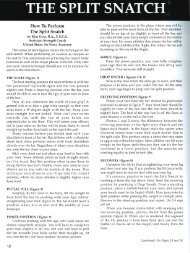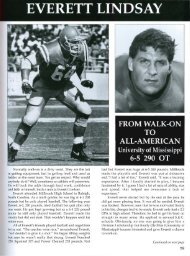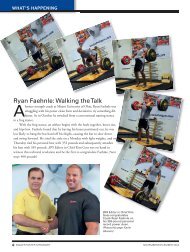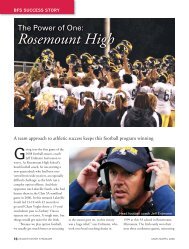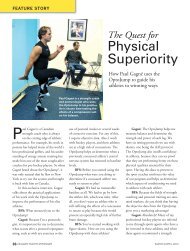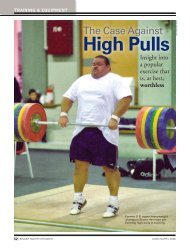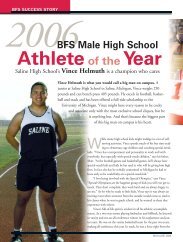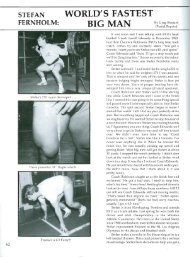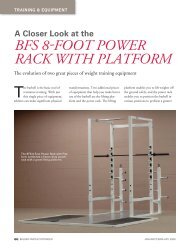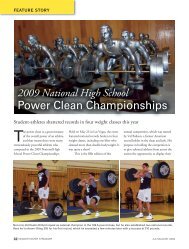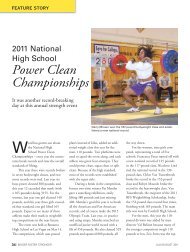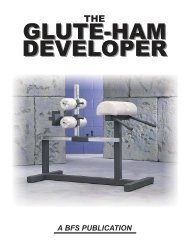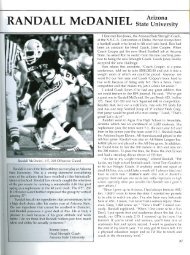POSITION PAPER • The Parrallel Squat - Bigger Faster Stronger
POSITION PAPER • The Parrallel Squat - Bigger Faster Stronger
POSITION PAPER • The Parrallel Squat - Bigger Faster Stronger
Create successful ePaper yourself
Turn your PDF publications into a flip-book with our unique Google optimized e-Paper software.
Figure 7: Weightlifters squat all the way<br />
down, but this depth is not necessary for<br />
most athletes and should only be used under<br />
the guidance of a qualified weightlifting<br />
instructor.<br />
coaches and judges. Notice the position of<br />
the side spotters. One spotter has his head<br />
behind the bar, and the other has his head in<br />
front. Spotters must get into these positions<br />
to judge the parallel squat. <strong>The</strong> side spotters<br />
should be in squat position on the sides with<br />
their hands underneath the bar. If something<br />
happens, it usually happens quickly, and the<br />
spotters need to be ready. Spotters cannot<br />
stand on the sides with their arms crossed.<br />
After the lifter completes the set, the side<br />
spotters grasp the bar and help the lifter back<br />
to the rack.<br />
Spotters need to be vocal in letting their<br />
teammate know how he or she is doing. No<br />
lifter can see or hear a nod of the head. Spot-<br />
ters should encourage their teammate during<br />
and immediately after the set by offering<br />
comments such as “Looking good,” “Great<br />
job,” “Awesome set,” “One more rep,” or<br />
“You can do it.”<br />
<strong>The</strong> back spotter should place his or her<br />
hands firmly on the bar at all times, from<br />
the moment the lifter gets under the bar<br />
to back out to when he or she puts the bar<br />
back on the rack after squatting. <strong>The</strong> back<br />
spotter places his or her hands on the bar<br />
for two reasons. First, the spotter can easily<br />
correct technique, especially when the lifter<br />
leans forward. <strong>The</strong> back spotter just pulls<br />
back slightly but firmly to correct the poor<br />
position. In addition, the back spotter should<br />
talk and encourage the lifter through the lift<br />
and set. Sometimes power lifters spot from<br />
behind with the arms going under the lifter’s<br />
armpits to the chest, but this assumes that<br />
technique problems are absent.<br />
In addition to proper technique, there<br />
is the issue of safety in performing the lift.<br />
Because relatively heavy weights can be used<br />
in the squat, it’s essential that proper spotting<br />
be used. Although it’s possible to squat safely<br />
with one spotter (standing behind the lifter),<br />
we prefer that three spotters be used (two<br />
at the side and one behind). In addition to<br />
spotting, the side spotters can judge spotting<br />
depth and technique and can encourage<br />
the athlete to break personal records. <strong>The</strong><br />
instructional video that is now available on<br />
our website will demonstrate proper spotting<br />
technique.<br />
Finally, proper equipment should be used.<br />
It’s best to squat inside a power rack, with<br />
safety pins adjusted to the proper height.<br />
However, the safety pins should be thought<br />
of as more “death control,” that is, a lastresort<br />
method of ensuring the safety of the<br />
athlete, as dropping any barbell on these<br />
pins from more than a few inches can easily<br />
damage the barbell. Also, it’s better to use<br />
Olympic barbells that have center knurling,<br />
to more properly secure the weight on the<br />
shoulders, and a stiffer barbell. <strong>The</strong> more<br />
flexible (and more expensive) Olympic bars<br />
are great for power cleans, but that same flexibility<br />
makes it difficult to control the barbell<br />
during a squat.<br />
Those are the basics of productive squatting.<br />
If you follow the guidelines closely,<br />
you’ll develop unbelievably strong quads,<br />
glutes, and hamstrings, a combination that<br />
translates into reduced susceptibility to<br />
injury, improved power, and greater athletic<br />
performance.<br />
When BFS started 32 years ago, one<br />
of the most controversial aspects of our<br />
program was our promotion of the squat.<br />
Most of the controversies were a result of<br />
misinformation, which we can now resolve<br />
with scientific research. Our original claim<br />
was that the parallel squat is one of the best<br />
exercises for athletes, and we continue to<br />
stand by it 100 percent.<br />
843 West 2400 South, Salt Lake City, UT 84119 Ph 800.628.9737 Fax 801.975.1159 www.biggerfasterstronger.com



